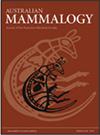适用于小型大型足类的DIY无线电项圈附件
IF 1.2
4区 生物学
Q3 ZOOLOGY
引用次数: 3
摘要
目前,很少有出版物报道如何以不同的方式将有领哺乳动物的压力降至最低。我们描述了一种DIY(自己动手;即自制)无线电项圈附件的构建,它可以改善小型大型动物无线电跟踪调查的动物福利结果。柔韧的项圈很轻,专为长期穿着而设计,可以拉伸,让被钩住的动物在不窒息的情况下自由活动。我们利用一种濒危大型动物种群的捕获和无线电项圈数据展示了我们的发现。在39个DIY无线电项圈中,25个保持了4个月以上的附着状态,4个在9-15周后自然脱落,10个通过其他机制(例如捕食事件)未附着。不良反应并不常见,我们对未来的无线电项圈研究提出了建议。本文章由计算机程序翻译,如有差异,请以英文原文为准。
DIY radio-collar attachment for small macropods
There is currently a paucity of publications reporting different ways of minimising stress in collared mammals. We describe the construction of a DIY (do-it-yourself; i.e. self-made) radio-collar attachment that can improve the animal welfare outcomes of radio-tracking surveys for small macropods. The flexible collar is light, designed for long-term wear, and can stretch to allow a snagged animal to free itself without choking. We present our findings using capture and radio-collaring data from a population of an endangered macropod. Of 39 DIY radio-collars, 25 remained attached for over four months, 4 fell off naturally after 9–15 weeks, and 10 were unattached by other mechanisms (e.g. a predation event). Adverse reactions were uncommon, and we present recommendations for future radio-collaring studies.
求助全文
通过发布文献求助,成功后即可免费获取论文全文。
去求助
来源期刊

Australian Mammalogy
ZOOLOGY-
CiteScore
2.50
自引率
8.30%
发文量
26
期刊介绍:
Australian Mammalogy is a major journal for the publication of research in all branches of mammalogy. The journal’s emphasis is on studies relating to Australasian mammals, both native and introduced, and includes marine mammals in the Antarctic region. Subject areas include, but are not limited to: anatomy, behaviour, developmental biology, ecology, evolution, genetics, molecular biology, parasites and diseases of mammals, physiology, reproductive biology, systematics and taxonomy.
Australian Mammalogy is for professional mammalogists, research scientists, resource managers, consulting ecologists, students and amateurs interested in any aspects of the biology and management of mammals.
Australian Mammalogy began publication in 1972 and is published on behalf of the Australian Mammal Society.
 求助内容:
求助内容: 应助结果提醒方式:
应助结果提醒方式:


